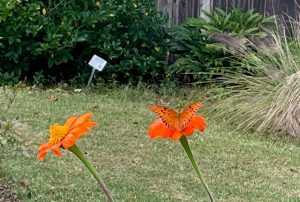
October is an important month for butterflies. The monarchs are making their epic migration towards Mexico, gracing us with their presence as they stop to feed on saltbush or milkweed plants along the coast. But our homegrown orange-and-black butterfly is showing up everywhere right now, too. The Gulf fritillary (Agrautis vanillae) is a smaller species, but also features bright orange wings with black stripes and spots. Their caterpillars come dressed for Halloween, too—they are a deep orange color with black legs and spikes. While the caterpillar is not venomous to any potential predators, the spikes are quite intimidating and serve a protective function.

Fritillary (name from the Latin “chessboard”) eggs are bright yellow and laid primarily on varieties of passionflower vines, which the caterpillars feed voraciously upon. Passion vine is an important host plant for the zebra longwing as well, which is Florida’s state butterfly.
Gulf fritillaries are found in all 67 Florida counties, and may live throughout the southeastern United States, Mexico, and central and south America. They are found in varied habitats but prefer open, sunny spots in fields, forests, and gardens. The butterfly’s wing shape puts them into the “longwing” category, as their elongated wings spread wider than other species.
In the fall, fritillaries migrate to the warmest ends of their range. By spring, they move slightly north into North Carolina or interior Alabama.
 6
6
